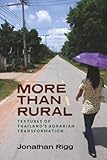More than Rural : Textures of Thailand's Agrarian Transformation / Jonathan Rigg.
Material type: TextPublisher: Honolulu : University of Hawaii Press, [2019]Copyright date: ©2019Description: 1 online resource (324 p.) : 14 b&w illustrations, 1 mapContent type:
TextPublisher: Honolulu : University of Hawaii Press, [2019]Copyright date: ©2019Description: 1 online resource (324 p.) : 14 b&w illustrations, 1 mapContent type: - 9780824876593
- 9780824877743
- 307.1/41209593 23
- HN700.55.A8 R54 2019eb
- online - DeGruyter
- Issued also in print.
| Item type | Current library | Call number | URL | Status | Notes | Barcode | |
|---|---|---|---|---|---|---|---|
 eBook
eBook
|
Biblioteca "Angelicum" Pont. Univ. S.Tommaso d'Aquino Nuvola online | online - DeGruyter (Browse shelf(Opens below)) | Online access | Not for loan (Accesso limitato) | Accesso per gli utenti autorizzati / Access for authorized users | (dgr)9780824877743 |
Browsing Biblioteca "Angelicum" Pont. Univ. S.Tommaso d'Aquino shelves, Shelving location: Nuvola online Close shelf browser (Hides shelf browser)

|

|

|

|

|

|

|
||
| online - DeGruyter Animated Encounters : Transnational Movements of Chinese Animation, 1940s-1970s / | online - DeGruyter A Place to Live : A New Translation of Yi Chung-hwan's T'aengniji, the Korean Classic for Choosing Settlements / | online - DeGruyter Mountain/Home : New Translations from Japan / | online - DeGruyter More than Rural : Textures of Thailand's Agrarian Transformation / | online - DeGruyter Nā Kahu : Portraits of Native Hawaiian Pastors at Home and Abroad, 1820-1900 / | online - DeGruyter The Sounds of Social Space : Branding, Built Environment, and Leisure in Urban China / | online - DeGruyter Soka Gakkai's Human Revolution : The Rise of a Mimetic Nation in Modern Japan / |
Frontmatter -- Contents -- List of Illustrations -- List of Tables -- Preface -- Acronyms -- CHAPTER 1: More than Rural -- CHAPTER 2: Inheritances -- CHAPTER 3: Spaces -- CHAPTER 4: Flourishing -- CHAPTER 5: Society -- CHAPTER 6: Land -- CHAPTER 7: Labor -- CHAPTER 8: Livelihoods -- CHAPTER 9: Class -- CHAPTER 10: Futures -- Glossary -- Notes -- References -- Index -- About the Author
restricted access online access with authorization star
http://purl.org/coar/access_right/c_16ec
In the 1970s, Thailand was developing but poor and largely agrarian. By the 1980s it had become the fastest growing large economy in the world and, in the process, made the transformation from a low-income to a middle-income economy. Fast forward to 2010 and Thailand had climbed yet another rung in the development ladder to become, according to World Bank criteria, an upper middle-income economy. Throughout this period of economic and social transformation, contrary to historical experience and theoretical models, one thing has remained constant: the central role of Thai smallholder farming. This conundrum-the persistence of the smallholder in a time of extraordinary change-lies at the heart of this book.In More than Rural author Jonathan Rigg explores how people in the countryside have adapted to their changing world, the new opportunities available, and the consequences for rural life and living. The Thai government has successfully "developed" the countryside, but with unexpected results. New household forms have emerged, women have become mobile in a manner few expected, and relations between rural and urban have changed. Yet the smallholder has persisted, and Rigg's attempts to understand why offer a fresh perspective on Thailand's development. Setting aside the urban, industrial point of view that we so often privilege, Rigg asks different questions about Thailand's development. What if, he wonders, the present changes are not simply way stations, transitions to the main act of urbanization? What if they represent a new form of rural livelihood?Rigg's thoughtful, nuanced approach to agrarian change-viewing the countryside as more than agriculture, the rural as more than the countryside, and rural people as more than farmers-offers insights into Thailand's wider transformations (class identities, intergenerational relations), its political impasse, and more. Based on over three-and-a-half decades of fieldwork in seventeen villages, across three regions, and encompassing more than one thousand households, and a deep knowledge of primary and published sources, More than Rural is a significant work with implications for contemporary development across Asia and the global South.
Issued also in print.
Mode of access: Internet via World Wide Web.
In English.
Description based on online resource; title from PDF title page (publisher's Web site, viewed 02. Mrz 2022)


